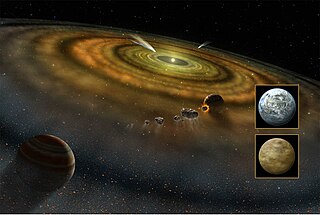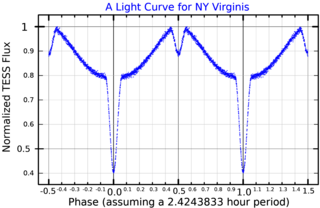Related Research Articles

V391 Pegasi, also catalogued as HS 2201+2610, is a blue-white subdwarf star approximately 4,000 light-years away in the constellation of Pegasus. The star is classified as an "extreme horizontal branch star". It is small, with only half the mass and a bit less than one quarter the diameter of the Sun. It has luminosity 34 times that of the Sun. It could be quite old, perhaps in excess of 10 Gyr. It is a pulsating variable star of the V361 Hydrae type. It is believed that the star's mass when it was still on the main sequence was between 0.8 and 0.9 times that of the Sun.

A B-type subdwarf (sdB) is a kind of subdwarf star with spectral type B. They differ from the typical subdwarf by being much hotter and brighter. They are situated at the "extreme horizontal branch" of the Hertzsprung–Russell diagram. Masses of these stars are around 0.5 solar masses, and they contain only about 1% hydrogen, with the rest being helium. Their radius is from 0.15 to 0.25 solar radii, and their temperature is from 20,000 to 40,000 K.

GSC 03549-02811 is a yellow main-sequence star similar to the Sun. This star is located approximately 704 light-years away in the constellation of Draco. The apparent magnitude of this star is 11.41, which means it is not visible to the naked eye but can be seen with a medium-sized amateur telescope on a clear dark night. The age of this star is about 5 billion years.
Kepler-39 is an F-type main sequence star located in the constellation Cygnus. It is located about 3,560 light-years away. One known substellar companion orbits it, Kepler-39b.
Kepler-70, also known as KIC 5807616 and KOI-55, is a star about 3,600 light-years away in the constellation Cygnus, with an apparent visual magnitude of 14.87. This is too faint to be seen with the naked eye; viewing it requires a telescope with an aperture of 40 cm (20 in) or more. A subdwarf B star, Kepler-70 passed through the red giant stage some 18.4 million years ago. In its present-day state, it is fusing helium in its core. Once it runs out of helium it will contract to form a white dwarf. It has a relatively small radius of about 0.2 times the Sun's radius; white dwarfs are generally much smaller. The star may be host to a planetary system with two planets, although later research indicates that this is not in fact the case.
Kepler-1520 is a K-type main-sequence star located in the constellation Cygnus. The star is particularly important, as measurements taken by the Kepler spacecraft indicate that the variations in the star's light curve cover a range from about 0.2% to 1.3% of the star's light being blocked. This indicates that there may be a rapidly disintegrating planet, a prediction not yet conclusively confirmed, in orbit around the star, losing mass at a rate of 1 Earth mass every billion years. The planet itself is about 0.1 Earth masses, or just twice the mass of Mercury, and is expected to disintegrate in about 100-200 million years. The planet orbits its star in just 15.7 hours, at a distance only two stellar diameters away from the star's surface, and has an estimated effective temperature of about 2255 K. The orbital period of the planet is one of the shortest ever detected in the history of the extrasolar planet search. In 2016, the planet was confirmed as part of a data release by the Kepler spacecraft.

Omega1 Cygni, Latinized from ω1 Cygni, is the Bayer designation for a solitary star in the northern constellation of Cygnus. It is visible to the naked eye with an apparent visual magnitude of 4.94. Based upon an annual parallax shift of 2.59 mas, it is estimated to lie roughly 1,260 light years from the Sun. Relative to its neighbors, this star has a peculiar velocity of 25.7±2.2 km/s.

An exocomet, or extrasolar comet, is a comet outside the Solar System, which includes rogue comets and comets that orbit stars other than the Sun. The first exocomets were detected in 1987 around Beta Pictoris, a very young A-type main-sequence star. There are now a total of 27 stars around which exocomets have been observed or suspected.

Kepler-69 is a G-type main-sequence star similar to the Sun in the constellation Cygnus, located about 2,430 ly (750 pc) from Earth. On April 18, 2013 it was announced that the star has two planets. Although initial estimates indicated that the terrestrial planet Kepler-69c might be within the star's habitable zone, further analysis showed that the planet very likely is interior to the habitable zone and is far more analogous to Venus than to Earth and thus completely inhospitable.
K2-3, also known as EPIC 201367065, is a red dwarf star with three known planets. It is on the borderline of being a late orange dwarf/K-type star, but because of its temperature, it is classified as a red dwarf.
2MASS J19383260+4603591 is a binary star system with at least one known planet, Kepler-451b. The system comprises two stars, a pulsating subdwarf B star as well as a small red dwarf star.
Kepler-1229 is a red dwarf star located about 870 light-years (270 pc) away from the Earth in the constellation of Cygnus. It is known to host a super-Earth exoplanet within its habitable zone, Kepler-1229b, which was discovered in 2016.
Kepler-1625 is a 14th-magnitude solar-mass star located in the constellation of Cygnus approximately 8,000 light years away. Its mass is within 5% of that of the Sun, but its radius is approximately 70% larger reflecting its more evolved state. A candidate gas giant exoplanet was detected by the Kepler Mission around the star in 2015, which was later validated as a likely real planet to >99% confidence in 2016. In 2018, the Hunt for Exomoons with Kepler project reported that this exoplanet has evidence for a Neptune-sized exomoon around it, based on observations from NASA’s Kepler Mission. Subsequent observations by the larger Hubble Space Telescope provided compounding evidence for a Neptune-sized satellite, with an on-going debate about the reality of this exomoon candidate.

NY Virginis is a binary star about 1,940 light-years away. The primary belongs to the rare class of subdwarf B stars, being former red giants with their hydrogen envelope completely stripped by a stellar companion. The companion is a red dwarf star. The binary nature of NY Virginis was first identified in 1998, and the extremely short orbital period of 0.101016 d, together with brightness variability on the timescale of 200 seconds was noticed, resulting in the identification of the primary star as a B-type subdwarf in 2003. Under a proposed classification scheme for hot subdwarfs it would be class sdB1VII:He1. This non-standard system indicates that it is a "normal" luminosity for a hot subdwarf and that the spectrum is dominated by hydrogen rather than helium.
Kepler-411 is a binary star system. Its primary star Kepler-411A is a K-type main-sequence star, orbited by the red dwarf star Kepler-411B on a wide orbit, discovered in 2012.
Kepler-635 is an F7V star with an extrasolar planetary system discovered by the Kepler space telescope. The star was first thought to be variable, but later determined to be static.
KIC 11145123, is a white hued star located in the northern constellation Cygnus, the swan. It has an apparent magnitude of 13.12, making it readily visible in large telescopes, but not to the naked eye. The object is located relatively far at a distance of approximately 3,910 light years, but is rapidly approaching the Solar System with a radial velocity of −136 km/s.
References
- ↑ Staff (2 August 2008). "Finding the constellation which contains given sky coordinates". DJM.cc. Retrieved 2 January 2021.
- 1 2 3 4 5 Vallenari, A.; et al. (Gaia collaboration) (2023). "Gaia Data Release 3. Summary of the content and survey properties". Astronomy and Astrophysics. 674: A1. arXiv: 2208.00211 . Bibcode:2023A&A...674A...1G. doi: 10.1051/0004-6361/202243940 . S2CID 244398875. Gaia DR3 record for this source at VizieR.
- 1 2 3 Jayasinghe, T; Kochanek, C S; Stanek, K Z; Shappee, B J; Holoien, T W-S; Thompson, Toda A; Prieto, J L; Dong, Subo; Pawlak, M; Shields, J V; Pojmanski, G; Otero, S; Britt, C A; Will, D (1 July 2018). "The ASAS-SN catalogue of variable stars I: The Serendipitous Survey". Monthly Notices of the Royal Astronomical Society. 477 (3): 3145–3163. arXiv: 1803.01001 . Bibcode:2018MNRAS.477.3145J. doi: 10.1093/mnras/sty838 . ISSN 0035-8711.
- 1 2 3 "Kepler-429 -- Hot subdwarf". SIMBAD . Centre de Données astronomiques de Strasbourg . Retrieved 2 January 2021.
- 1 2 3 4 Mathur, Savita; Huber, Daniel; Batalha, Natalie M.; Ciardi, David R.; Bastien, Fabienne A.; Bieryla, Allyson; Buchhave, Lars A.; Cochran, William D.; Endl, Michael; Esquerdo, Gilbert A.; Furlan, Elise; Howard, Andrew; Howell, Steve B.; Isaacson, Howard; Latham, David W.; MacQueen, Phillip J.; Silva, David R. (2017). "Revised Stellar Properties of Kepler Targets for the Q1-17 (DR25) Transit Detection Run". The Astrophysical Journal Supplement Series. 229 (2): 30. arXiv: 1609.04128 . Bibcode:2017ApJS..229...30M. doi: 10.3847/1538-4365/229/2/30 . S2CID 39426786.
- 1 2 Loyd, R. O. Parke; Shkolnik, Evgenya L.; Schneider, Adam C.; Richey-Yowell, Tyler; Barman, Travis S.; Peacock, Sarah; Pagano, Isabella (2020). "Current Population Statistics do Not Favor Photoevaporation over Core-powered Mass Loss as the Dominant Cause of the Exoplanet Radius Gap". The Astrophysical Journal. 890 (1): 23. arXiv: 1912.12305 . Bibcode:2020ApJ...890...23L. doi: 10.3847/1538-4357/ab6605 . S2CID 209516410.
- ↑ Uzundag, M.; Baran, A. S.; Østensen, R. H.; Reed, M. D.; Telting, J. H.; Quick, B. K. (2017). "KIC 10001893: A pulsating SDB star with multiple trapped modes". Monthly Notices of the Royal Astronomical Society. 472 (1): 700. arXiv: 1812.05675 . Bibcode:2017MNRAS.472..700U. doi:10.1093/mnras/stx2011.
- ↑ Silvotti, R.; Charpinet, S.; Green, E.; Fontaine, G.; Telting, J. H.; Østensen, R. H.; Van Grootel, V.; Baran, A. S.; Schuh, S.; Fox Machado, L. (2014). "Keplerdetection of a new extreme planetary system orbiting the subdwarf-B pulsator KIC 10001893". Astronomy & Astrophysics. 570: A130. arXiv: 1409.6975 . Bibcode:2014A&A...570A.130S. doi:10.1051/0004-6361/201424509. S2CID 46974308.
- ↑ Blokesz, A.; et al. (July 2019). "Analysis of putative exoplanetary signatures found in light curves of two sdBV stars observed by Kepler". Astronomy & Astrophysics . 627: A86. arXiv: 1906.03321 . Bibcode:2019A&A...627A..86B. doi:10.1051/0004-6361/201835003. S2CID 182952925.
- ↑ "Eyes On Exoplanets – Exoplanet Exploration: Planets Beyond our Solar System". exoplanets.nasa.gov. Retrieved 2023-12-21.
- ↑ "KIC 10001893". NASA Exoplanet Archive . Retrieved 2 January 2021.
- ↑ "Eyes On Exoplanets – Exoplanet Exploration: Planets Beyond our Solar System". exoplanets.nasa.gov. Retrieved 2023-12-21.
- ↑ "Eyes on Exoplanets-KIC 10001893 c".
- ↑ "Eyes on Exoplanets-KIC 10001893 d".